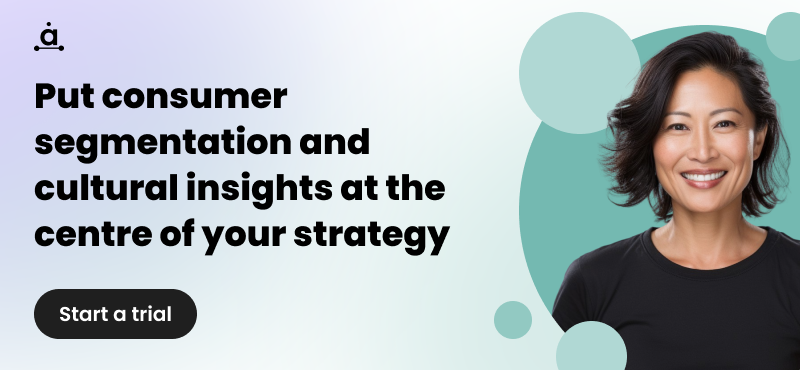How to do an audience analysis the right way in 2025
Apple Vision Pro - maybe you’ve heard of it but you likely don’t own one. Not many people do. This is because even big name brands like Apple fall into the trap of creating something their audience wasn’t actually asking for.
In reality, Apple’s customers found that the product had an insanely high price tag and limited functionality, and they described the headset and battery pack as annoyingly heavy.
For any brand, no matter how big or small, this could have been avoided with proper audience analysis - prior to product development.
Had Apple done the proper research beforehand, maybe what they would have discovered is that their audience wasn’t ready for a product this advanced, and in fact, they were just looking for efficiencies to be created within the products Apple already produces. There could be a segment of Apple consumers for example, that are gamers, who love Apple products but find that their MacBook “isn’t as versatile as Windows devices and the lack of macOS games make it less ideal for gaming”.
This key insight can be unearthed using audience analysis which tells you exactly what your customers are thinking, how they are feeling, and what they need from you as a brand and the products you create (a MacBook more optimized for gaming).
It never has to be a guessing game when it comes to knowing what your audience wants if the right data is available. And luckily because of audience analysis tools, it is - let us show you.
What is audience analysis?
To recap, Audience analysis is the process of collecting as much information as possible about your audience to better understand who they are, what they care about, and what they need.
Audience research has long been a part of doing business, but today audience analysis is easier than ever. This is because brands now have access to a huge amount of audience data via social media.
If you can effectively turn all that social data into clear insights about who your audience is and what they care about most, you can use what you learn to build a more successful all-around business strategy.
Why is audience analysis important?
Audience analysis is important because you can’t effectively communicate or market to an audience you don’t understand, or like the case of the Apple Vision Pro, you end up creating products they don’t need.
For businesses, reaching the right people and crafting a message that resonates with them is crucial for success.
Beyond gaining a basic understanding of who your audience is (and who it isn’t), audience analysis is important because it helps you answer a number of strategic business questions, such as:
- What platforms and channels should we invest in? If you know your audience hangs out on Twitter or TikTok more than Instagram, you can focus your efforts accordingly.
- What types of topics should our content cover? Social data reveals the types of content your audience is sharing and topics they’re discussing online which helps you create a content calendar relevant to what they’re already reading and consuming
- What kind of factors do our customers consider when choosing a brand? Are they price conscious consumers who often talk about discounts and deals? Or are they quality seekers that talk about their favorite name brands? Social data can help you pick up on their shopping habits.
- What values are most important to our audience? Consumers increasingly factor brand values into their shopping choices. Social audience analysis offers insights into what values matter to them, so you can match your company’s actions and messaging to their priorities.

The different types of audience analysis
Audience analysis, in practice, can take on a few different forms. Ther is social, branded, unbranded, competitor, demographic, and psychographic - all with their own use cases and benefits.
Social audience analysis
Social audience analysis uses the extensive data social media platforms have about active users to help brands understand their audience.
You can use whatever tool you want but in this case, we are conducting a social audience analysis using the tool TweetBinder, to find out how many people are discussing a specific Netflix show on Twitter, and whether the sentiment is negative or positive:
This report type is great for understanding who is talking about your brand when you release a new product or when you are in the news for example, or it can be useful when something is trending online and you want to assess the audience behind that trend.


Run your first social audience analysis report with Audiense today
Branded audience analysis
Branded audience analysis is focused on identifying and understanding the audience of a specific brand, whether your own or that of another company in your space.
In the example below, we’ve used the tool SOPRISM to run a branded audience analysis on the Coors Light brand:
Running a branded report on your own audience is helpful to get a full view of all the different groups of consumers that live within your audience, to make sure you are targeting them all effectively.

Run your own branded audience report with Audiense today!
Unbranded audience analysis
Unbranded audience analysis is about understanding an audience with something other than a shared brand in common, such as customers of a general product type or readers of a particular publication.
This example report we ran using Audiense is unbranded, so it was run to collect people who buy beauty products instead of an audience of a particular beauty brand:
An unbranded report can be perfect for surfacing the insights you need on a lifestyle group or consumer group that you have not yet captured but are hoping to target. For example, if you wanted to target beauty product consumers, running an audience analysis like the one below could uncover all the different sub-segments of audiences that buy beauty products, which all need to be treated and targeted differently.

Try Audiense and run a report on any audience you’re looking to analyze and learn more about.
Competitor audience analysis
Competitor audience analysis is when you identify and analyze data about the audiences of your competitors.
Here’s a report that LEGO for example could run on its competitor Mega Bloks’s audience, in hopes of discovering where to target them with LEGO ads:
Competitive reports are so useful when it comes to understanding the gaps in your own audience. If your competitor has been able to win over different consumer groups, you should be able to win them over by using the audience insights that tools like Audiense can surface.

Take a peek at your competitor’s audience and discover the audiences you might be ignoring or missing from your own customer list.
Demographic audience analysis
Demographic audience analysis is done by categorizing and analyzing an audience based on specific demographic categories, like age, gender, and geographic location. This is your typical audience analysis breakdown most companies do.
The report below was created to collect insights on “moms from the US”, a broad demographic of people that many brands are looking to understand and target:
Demographic audience analysis is so important when you want to target a broader audience because there are so many different groups of “moms from the US”, and as a brand, you need to know what makes them different and alike. A group of “Vegan Liberal Moms” would resonate with ads that probably look a lot different than the ones that would resonate with “Christian Comfort Food Moms”.

Psychographic audience analysis
Psychographic audience analysis is when you categorize and analyze an audience based on factors like affinity, interests, and values.
Below is a report that collected an audience that shares an interest in gaming. Especially when analyzing an audience of a broader interest category, it’s good to uncover all the different groups of gamers that you otherwise wouldn’t know existed.

Run a report and find any interest-based group to analyze and instantly understand them on a deeper level.
As you can see, all forms of audience analysis serve a different purpose when it comes to targeting a specific audience group.

How to conduct audience analysis
The particulars of how to do audience analysis will vary based on your tools, resources and needs, but a good audience analysis process will often include the following steps.
You can download this checklist next time you do an audience analysis, to make sure you’ve covered all the bases.
1. Select an audience analysis tool
Social media offers a ton of audience data, which is mostly a good thing. But if you try to monitor and analyze it all manually it can be overwhelming.
An audience research tool simplifies the audience analysis process. It makes monitoring audience insights much more efficient and paves the way to gaining more useful information.
Here’s a good guide to help you select the best tool for your needs:
2. Clarify what questions you want to answer
Your audience analysis process will have more focus if you determine what you want to get from it at the outset. Determine the specific goals you have in mind so you can shape your research based on your needs.
Example: “I want to know how to target ‘Health & Fitness’ people with ads for our zero sugar ‘healthy’ energy drink option”
.png?width=483&height=463&name=image9%20(25).png)
3. Decide what to create your audience based on
Based on the questions you selected in the last step, figure out what common factor to use in creating your audience. If it’s a branded audience, that will mean using your customer list, one of your brand accounts, or that of a competitor. If it’s unbranded, you may want to use a keyword, hashtag, or particular profile attribute like job role.
Example: “To find this “Heath & Fitness” audience we are going to run a competitor audience report on our competitor Celsius”
4. Generate an audience report
Again, there are plenty of tools you can use but for this example, we are using Audiense because it’s incredibly quick and easy to generate a detailed report once you’ve defined your audience.

Now you can start digging into the data. Notice how within this Celsius competitive report we can see that the target audience of interest, is the ‘Health & Fitness’ segment.
From there, you can dive into that segment and understand what people make up that audience to dial in your marketing efforts.
When interpreting segments within your audience, keep this in mind:
- The largest segment is the segment of your most loyal customers, these are the people you need to keep in mind when creating new products
- The smallest cluster is the segment that needs the most attention, you should be targeting this audience and audiences that look like them to further grow this segment
- Are there any segments that surprise you? Maybe a segment emerged that you never planned on capturing, but you have - make sure you are creating campaigns and products with them in mind too
- Run an analysis on your competitor's audience to see if there are any clusters in their audience that you have not captured or considered that you should start to
5. Use the data to answer your initial question
The report produced will contain a lot of different information. Spend some time with it to see what you learn, but don’t get too distracted from your initial goal. Keep the question you started the process with top of mind, and use the knowledge contained in the report to find the answer. Then repeat the process with any other goals or questions you have.
Example: The initial question was “How do I target ‘Health & Fitness’ people with ads for our zero sugar ‘healthy’ energy drink option?”
Sifting through the Audiense report, we’ve found that cluster of ‘Health & Fitness’ individuals.
After our full audience analysis, we’ve found the top influencers of interest for this ‘Health & Fitness’ segment. To target this audience effectively we should work with these influencers to promote our zero sugar ‘healthy’ energy drink option, knowing that this audience follows and looks up to these influencers:

If you follow these steps when you set out to analyze your audience, you will be in good shape and put yourself in the top 1% of companies that do audience analysis the right way.
What else to look for:
- Your audience's top interest categories and interests (ie. Sports, Education, Basketball, Pets)

- Who your audience is influenced by
- Which type of content are they reading and which type of posts are they engaging with
- What are their top personality traits?
- What does your audience value most (ie. “Taking pleasure in life and helping others”)

- What needs are they expressing?
- Where do they hang out online, and which social channels do they spend the most time on (ie. TikTok, WhatsApp, Snapchat, Spotify)

What next? How to turn these insights into marketing strategies:
So you’ve got access to all of these audience insights, now what? Here’s how you can take what you’ve learned and apply it:
- Build out detailed customer personas that summarize the insights you just collected, that everyone on your team can refer back to when they are creating marketing materials
- Inform media buying; see which channels on social/the web/tv your audience favourites so that you divvy up your ad spend for maximum ROI
Example: Looking at the Coors Light audience, peek at their Media Affinities; if you were to target this audience the data would tell you that you would want to spend the majority of your ad budget on SportsCenter, ESPN and the NFL Network in order to get your brand name and ad in front of them.

- Select or vet influencers based on the top influencers your audience shows an affinity towards
- Create products that align with the audience’s core needs, values and personality traits in mind
- Create campaigns that resonate with your audience's top interests
- Use audience insights to re-build the exact same audiences on social media to target them more effectively
- View their content consumption and see which articles/ blogs/ social posts they resonate with so that the content you create aligns with what they are most interested in
Example: Looking at the Coors Light audience again, we can surface the top posts their audience is liking. From this we can infer that this audience is more likely to engage with a soccer-related post that is vibrant in colour:
Goalless draw in Zagreb... #UCL pic.twitter.com/JXtuJCbScH
— UEFA Champions League (@ChampionsLeague) December 10, 2024
Michigan State HC Tom Izzo and Oakland HC Greg Kampe are wearing Grinch sweaters 😂 pic.twitter.com/8msyE23SRw
— SportsCenter (@SportsCenter) December 18, 2024
YYYYYYYYEEEEESSSSSSSSS!!!!!!! pic.twitter.com/BXirTZgpjR
— Leeds United (@LUFC) December 10, 2024
- Sponsor the events you know your audience is attending * show picture
- Partner with brands that your audience also has an interest in
The list goes on, and the possibilities are endless, but no matter what marketing strategy you are creating there is a way to apply audience insights to it, to make sure it’s a success.
New trends in audience analysis
Personalization: so many brands are prioritizing customer personalization in 2025 because that is what customers are asking for.
Audience analysis tools are incorporating AI and other advancements that are making it easier to do personalization at scale. Audiense uses AI to take a broad audience and automatically segment it out into different, smaller clusters based on their shared interests and affinities making personalization for each cluster an easy task.
For example, when you think of Coors Light’s audience you might picture a person that in your mind represents their entire audience but when you run a report in Audiense, it collects ALL Coors Light drinkers and segments them into smaller groups based on things they have in common: their shared interests and behaviors, like this:

.png?width=244&height=505&name=image13%20(15).png)
The “NASCAR Passion” segment is a smaller cluster that combined with the other clusters makes up the Coors Light audience, but the NASCAR Passion segment needs a separate marketing campaign, content with different images and tones, a different influencer strategy etc. for Coors to resonate with them.
Gone are the days of sending or receiving generic brand emails (we hope) when there are audience analysis features like this.
Real-time audience analysis: as a brand, insights that are days old are old news. There is more and more of a need for brands to be on top of emerging trends or be able to detect what will become the latest trend, this requires access to real-time audience data.
TweetBinder for example, has the option at the top right, for its users to re-run any X (Twitter) audience report in real time. This is becoming more common especially when a brand is looking at what people are saying about them online because they’re looking for a current sentiment, not one that their audience held in the past.

Brands with access to real-time audience analysis have an advantage over their competitors who don’t. At the rate that consumer preferences change and trends emerge, imagine working with data that’s a week old and your competitor has access to data that is seconds old - your competitor's marketing strategy would be way more relevant and fine tuned.
That’s why all of Audiense’s products offer real-time insights, while still allowing you to look into the past for an easy comparison.
Audience analysis tool integration: We are seeing audience analysis brands buy up other analysis tools and integrate them, so customers have access to even more data and insights that complement each other.
Audiense acquired audience analysis tool Affinio and has already integrated some of the Affinio features into its UI, like the new network graph. Hootsuite just
Audiense in action
Audiochuck, a podcast company, used Audiense as its audience analysis tool. With Audiense they were able to analyze target audiences and uncover things like psychographics, behaviors and emotional drivers that they weren't privy to before.
They applied these insights to content, podcast promotion, and partnerships all personalized to distinct listener groups.
The results were incredible - they were able to boost engagement, loyalty and conversions all while building and fostering a deeper relationship with their listeners.
Audiense insights lead to content experimentation and refinement, and it helped them align their brand with the needs of their listeners.
Ultimately, Audiochuck formed a stronger connection with its listeners, grew its listener base, and was able to increase audience engagement. A big win for the brand, and an amazing example of the effect proper audience analysis can have.
Read the full case study details here.
Using Audiense for audience analysis
Audience analysis can be a powerful tool for improving business outcomes. But to achieve any of the benefits it can offer, you need the means to do it well. Audiense Insights makes identifying relevant audiences and understanding who they are fast and easy. And it goes beyond basic demographics to help you grasp what your audience truly cares about, and what communities they’re a part of. All of that adds up to knowledge you can use to more effectively connect with them in the ways that matter most for your brand.






.png?width=680&height=869&name=image8%20(29).png)
